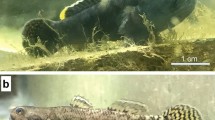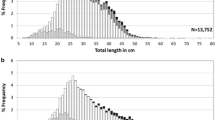Abstract
Monthly trends shown by gonadosomatic indices, the prevalence of the different gonadal stages, and the size distribution of the oocytes, indicate that the large marine and commercially important plotosid Cnidoglanis macrocephalus spawns in Wilson Inlet between October and January. The conclusion that spawning occurs within this seasonally closed estuary was confirmed by the presence of males in large nests and by the capture of newly-hatched, yolk sac larvae from one of those nests. The fact that C. macrocephalus, which is also widely distributed in coastal marine waters throughout much of southern Australia, can spawn within Wilson Inlet would be of particular value to this species in those periods when closure of the estuary would preclude a seawards spawning migration. Sexual maturity is size dependent, with spawning rarely occurring before fish have reached a total length of 425 mm. Sexual maturity was attained by a few fish at the end of their second year, by several at the end of their third year and by most, if not all fish, at the end of their fourth year. Comparisons with data for the more northern and permanently open Swan Estuary indicate that C. macrocephalus also spawns within that system and that the spawning time of this species is related to water temperature. The adult male guards the larvae under its pelvic fins in burrows. The larvae increased in total length from 29 mm just after hatching to 43 mm in the 17–18 days after capture, during which time their yolk sac was resorbed. Details are given of the morphology, morphometrics, meristics and pigmentation of larval C. macrocephalus. In comparison with the larvae of three other plotosid genera, the larva of C. macrocephalus is far larger in size and more developed at hatching and takes a shorter time to transform into a juvenile.
Similar content being viewed by others
References
Anon., 1991. Yearbook Australia, No. 74. Australian Bureau of Statistics, Canberra. Commonwealth Printer, Canberra, 790 pp.
Breder, Jr., C. M. & D. E. Rosen, 1966. Modes of Reproduction in Fishes. T.F.H. Publications, Jersey City, New Jersey, USA 941 pp.
Chrystal, P. J., I. C. Potter, N. R. Loneragan & C. P. Holt, 1985. Age structure, growth rates, movement patterns and feeding in an estuarine population of the cardinalfish Apogon rueppellii. Mar. Biol. 85: 185–197.
Claridge, P. N., I. C. Potter & M. W. Hardisty, 1986. Seasonal changes in movements, abundance, size composition and diversity of the fish fauna of the Severn Estuary. J. mar. biol. Ass. U.K. 66: 229–258.
Davis, T. L. O., 1977. Reproductive biology of the freshwater catfish, Tandanus tandanus Mitchell, in the Gwydir River, Australia. II. Gonadal cycle and fecundity. Aust. J. mar. Freshwat. Res. 28: 159–169.
Hodgkin, E. P. & R. Clark, 1988. Estuaries and coastal lagoons of south western Australia. An inventory. No. 3. Wilson Inlet, Irwin Inlet and Parry Inlet. Environmental Protection Authority, Perth, Western Australia. Estuarine Studies Series No. 3, 1–42.
Hoese, D. F. & J. E. Hanley, 1989. Fishes (Part 1). In J. R. Paxton, D. F. Hoese, G. R. Allen & J. E. Hanley (eds), Zoological Catalogue of Australia. 7. Pisces. Petromyzontidae to Carangidae. Australian Government Printing Service, Canberra: 222–226.
Hosoya, K, 1988. Plotosidae. In M. Okiyama (ed.), An Atlas of the Early Stage Fishes in Japan. Tokay University Press, Tokyo: 167–168. (In Japanese).
Hyndes, G. A., F. J. Neira & I. C. Potter, 1992a. Reproductive biology and early life history of the marine teleost Platycephalus speculator (Platycephalidae) in a temperate Australian estuary. J. Fish Biol. 40: 859–874.
Hyndes, G. A., N. R. Loneragan & I. C. Potter, 1992b. Influence of sectioning otoliths on marginal increment trends and age and growth for the flathead, Platycephalus speculator. Fish. Bull. U.S. 90: 276–284.
Kowarsky, J., 1976. Clarification of the name and distribution of the plotosid catfish Cnidoglanis macrocephalus. Copeia 1976, No. 3: 593-594.
Laevastu, T., 1965. Manual of methods in fisheries biology. Fascicule 9. Section 4. Research on fish stocks. F.A.O. Manuals in Fisheries Science No. 1, F.A.O., Rome. 51 pp.
Lake, J. S, 1967a. Rearing experiments with five species of Australian freshwater fishes. I. Inducement to spawning. Aust. J. mar. Freshwat. Res. 18: 137–153.
Lake, J. S., 1967b. Rearing experiments with five species of Australian freshwater fishes. II. Morphogenesis and ontogeny. Aust. J. mar. Freshwat. Res. 18: 155–173.
Leis, J. M. & T. Trnski, 1989. The Larvae of Indo-Pacific Shorefishes. New South Wales University Press, Sydney, 371 pp.
Lenanton, R. C. J. & I. C. Potter, 1987. Contribution of estuaries to commercial fisheries in temperate Western Australia and the concept of estuarine dependence. Estuaries 10: 28–35.
Merrick, J. R. & S. H. Midgley, 1981. Spawning behaviour of the freshwater catfish Tandanus tandanus (Plotosidae). Aust. J. mar Freshwat. Res. 32: 1003–1006.
Neira, F. J., 1992. Larval development of the oral brooding cardinalfish Apogon rueppellii (Teleostei: Apogonidae) in Western Australia. Rec. West. Aust. Mus. 15: 573–584.
Nel, S. A., I. C. Potter & N. R. Loneragan, 1985. The biology of the catfish, Cnidoglanis macrocephalus (Plotosidae), in an Australian estuary. Estuar. coast. mar. Sci. 21: 895–909.
Orr, T. M. & N. E. Milward, 1984. Reproduction and development of Neosilurus ater (Perugia) and Neosilurus hyrtlii Steindachner (Teleostei: Plotosidae) in a tropical Queensland stream. Aust. J. mar. Freshwat. Res. 35: 187–195.
Potter, I. C., W. Ivantsoff, R. Cameron & J. Minnard, 1986. Life cycles and distribution of atherinids in the marine and estuarine waters of southern Australia. Hydrobiologia 139: 23–40.
Potter, I. C., L. E. Beckley, A. K. Whitfield & R. C. J. Lenanton, 1990. Comparisons between the roles played by estuaries in the life cycles of fishes in temperate Western Australia and southern Africa. Env. Biol. Fish 28: 143–178.
Potthoff, T., 1984. Clearing and staining techniques. In H. G. Moser, W. J. Richards, D. M. Cohen, M. P. Fahay, A. W. Kendall, Jr. & S. L. Richardson (eds), Ontogeny and Systematics of Fishes. American Society of Ichthyologists and Herpetologists. Special Publication No. 1, 35–37.
Thomson, J. M., 1957. The size at maturity and spawning times of some Western Australian estuarine fishes. Fish. Bull. West. Aust. No. 8, 1–8.
Author information
Authors and Affiliations
Rights and permissions
About this article
Cite this article
Laurenson, L.J.B., Neira, F.J. & Potter, I.C. Reproductive biology and larval morphology of the marine plotosid Cnidoglanis macrocephalus (Teleostei) in a seasonally closed Australian estuary. Hydrobiologia 268, 179–192 (1993). https://doi.org/10.1007/BF00014053
Received:
Revised:
Accepted:
Issue Date:
DOI: https://doi.org/10.1007/BF00014053




